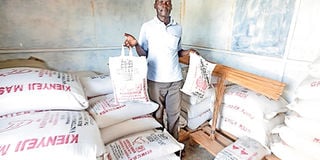We set up animal feed processing firm with Sh50,000

Benjamin Makokha displays some of the feeds their enterprise makes at the Riat Centre. To formulate the feeds, they use ingredients such as maize germ, wheat pollard, soya beans and omena, and also source sunflower and cotton seed cake from Tanzania and Uganda. PHOTO | ELIZABETH OJINA | NATION MEDIA GROUP
What you need to know:
- Soya beans are among the key ingredients the duo use to make animals feeds for poultry, pigs and dairy cows.
- Having studied animal health at Kabete Training Institute, Makokha is in charge of feed formulation while Okuku, a former lab technician, doubles up as the director and salesperson.
- To make the feeds, they use ingredients such as maize germ, wheat pollard, soya beans and omena. They also source sunflower and cotton seed cake from Tanzania and Uganda.
- In a good month, Okuku notes that the firm makes up to Sh200,000 from sale of animals feeds.
At Riat Centre, off Kisumu-Busia highway, Eliakim Okuku and Benjamin Makokha are busy making animal feeds at their enterprise dubbed Victoria Feeds.
The manufacturing unit is an aluminium sheet structure, where Seeds of Gold team finds two workers roasting soya beans in a metal drum.
The heat is intense and the workers have to keep on turning the grains with wooden stick so that they do not burn.
Soya beans are among the key ingredients the duo use to make animals feeds for poultry, pigs and dairy cows.
It all started in 2000 when Okuku shared his idea of starting a poultry farm with his friend Makokha. While Makokha supported the idea, he had a better one of setting up a feeds processing enterprise.
“We realised most farmers in the region had a challenge getting a steady supply of quality feeds for their birds. Some had to buy from as far as Nairobi or Nakuru,” recalls Okuku, adding that a survey they did showed feed-making materials like maize and omena were readily available locally.
With Sh50,000 capital, the duo bought raw materials and a locally made miller to start the business. They hired a structure for which they paid Sh5,000 rent and went into business.
Having studied animal health at Kabete Training Institute, Makokha is in charge of feed formulation while Okuku, a former lab technician, doubles up as the director and salesperson.
“To start an animal feeds processing enterprise, you need a permit from the county government as well as National Environment Management Authority, public health and Kenya Bureau of Standards certification,” says Okuku.
To make the feeds, they use ingredients such as maize germ, wheat pollard, soya beans and omena. They also source sunflower and cotton seed cake from Tanzania and Uganda.
QUALITY MATERIALS
“Using the raw materials we make chick, growers, layers and Kienyeji mashes,” says Makokha, noting that the machines they have for feed processing are locally fabricated hammer miller, half-tonne mixer and stitching machine.
Their current production is 2,000kg of animal feeds daily and have employed four people permanently and hire others on need basis.
They package their feeds in 5kg, 10kg, 20kg and 50kg bags. For Kienyeji mash, 5kg goes at Sh200, 10kg at Sh350, 20kg at Sh700 and 50kg at Sh1,500.
Chick mash, on the other hand, goes from Sh250 to Sh2,200 while growers mash is sold at between Sh400 and Sh1,750 while layers Sh450 to Sh2,000.
In a good month, Okuku notes that the firm makes up to Sh200,000 from sale of animals feeds.
“We were growing steadily but over the years we have seen a change in trend where many farmers are now buying raw materials to make their own feeds,” says Okuku, noting this has affected their business.
He added that the business tends to go down during the electioneering period, when most farmers sell off their poultry for fear interruption of access to feeds.
Lake Basin Development Authority agronomist Amos Amenya says to make good animal feeds, one should source for quality materials for feed formulation.
“You need to blend carbohydrates, proteins, minerals and vitamins. The feeds should have good shelf life, depending how well they are dried and stored. Avoid dump place that can lead to aflatoxin,” he says.
He observes that before getting into the business, one should have a reliable place where they would get the ingredients.
“It is important to do market research, get to know your consumers and do market sampling before finally rolling out for the commercial market. Ensure you have enough space to store raw materials and end products.”




